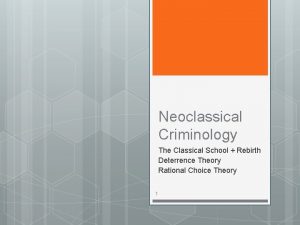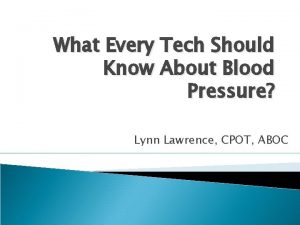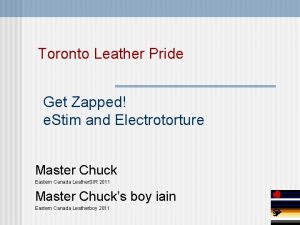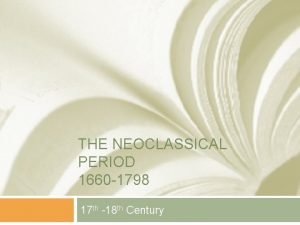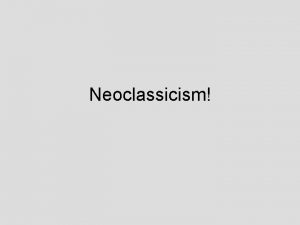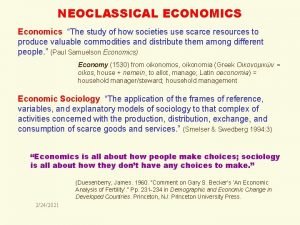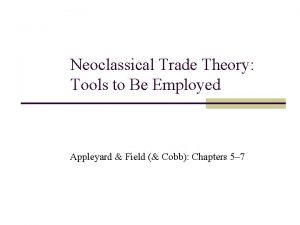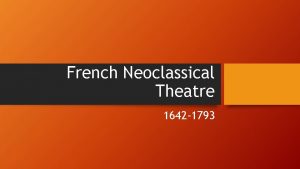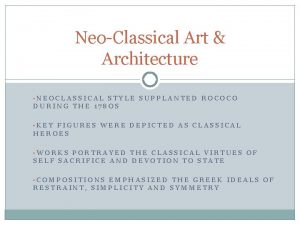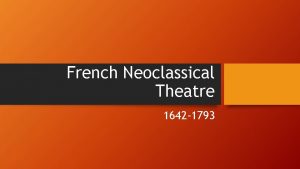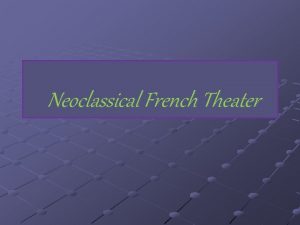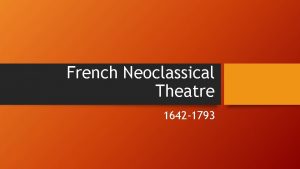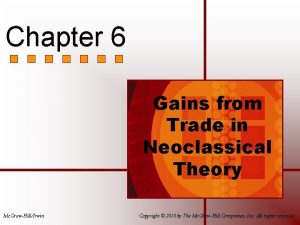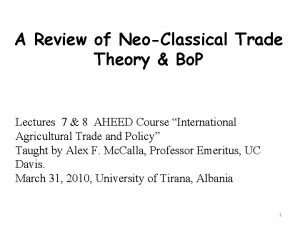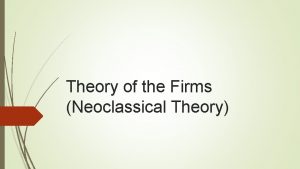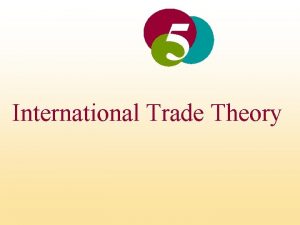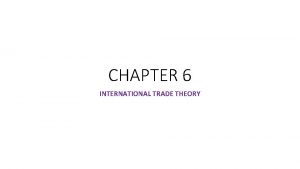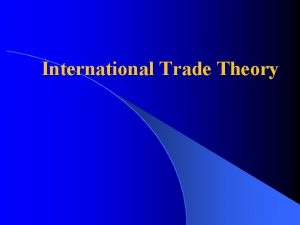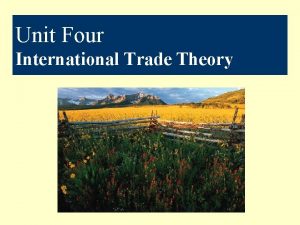Chapter 5 Introduction to Neoclassical Trade Theory Tools





















- Slides: 21

Chapter 5 Introduction to Neoclassical Trade Theory: Tools to Be Employed Mc. Graw-Hill/Irwin Copyright © 2010 by The Mc. Graw-Hill Companies, Inc. All rights reserved.

Learning Objectives § Review the microeconomic principles of consumer and producer behavior. § Explain the concepts and limitations of a community indifference curve. § Examine the underlying basis for a production possibilities frontier with increasing opportunity costs. 5 -2

Consumer Behavior Theory § How do consumers decide how much of each good to consume? 5 -3

Consumer Indifference Curves Y Consumers are indifferent between pt. A and pt. B, and all other pts. on the CI. A There are many, many CIs each representing higher or lower levels of consumer satisfaction. B X 5 -4

Consumer Indifference Curves Y Utility on S 3 > Utility on S 2 > Utility on S 1 S 3 S 2 S 1 X 5 -5

Consumer Indifference Curves § are downward sloping because the goods are substitutes. § Slope is marginal rate of substitution (MRS): MUx/MUy. § are convex because of the principle of diminishing MRS. § represent the welfare of an entire country, not an individual. 5 -6

Consumer Budget Constraint Y Budget constraint shows combinations of X and Y that can be purchased with a given level of income at fixed prices. The slope of the budget constraint is –Px/Py. X 5 -7

Consumer Equilibrium § Given relative prices (PX/PY) and income, consumers will choose a combination of X and Y that puts them on the highest possible community indifference curve. § Consumer equilibrium occurs where (MUX/MUY) = (PX/PY). 5 -8

Consumer Equilibrium Y Budget constraint E S 3 S 2 S 1 X 5 -9

Production Theory § How do producers choose the mix of inputs to use? § What determines production efficiency within the firm? 5 -10

Isoquants Capital (K) Isoquants shows the combinations of K and L that produce the same level of output. A Producers can generate the same level of output using more K and less L (pt. A) or using less K and more L (pt. B). B Labor (L) 5 -11

Isoquants K Output on Q 3 > Output on Q 2 > Output on Q 1 Q 3 = 125 units of output Q 2 =100 units of output Q 1 = 75 units of output L 5 -12

Isoquants § are downward sloping because K and L are substitutes. § Slope is marginal rate of technical substitution (MRTS): MPPL/MPPK. § MRTS declines as more L and less K are used. § We’ll assume that production exhibits constant returns to scale. 5 -13

Isocost Lines K Isocost line shows combinations of K and L that can be purchased with a given level of total cost at fixed factor prices. The slope of the budget constraint is –PL/PK or –w/r. L 5 -14

Producer Equilibrium § Given relative factor prices (w/r) and cost, producers will choose a combination of K and L that generates the maximum output. § Producer equilibrium occurs where (MPPL/MPPK) = (w/r). 5 -15

Producer Equilibrium K isocost line E Q 3 Q 2 Q 1 L 5 -16

The Edgeworth Box § If we have two industries, it is instructive to combine isoquantisocost diagrams for each into a single diagram. § This construct is called an Edgeworth box. 5 -17

Edgeworth Box 5 -18

Production Possibilities Frontier § Most PPFs are bowed out, not straight lines. § This is because resources are not equally suited to all kinds of production. 5 -19

Production Possibilities Frontier § Slope of a tangent line at any point along the PPF is: • the marginal rate of transformation, or • the opportunity cost of the horizontal axis good, or • MCX/MCY. 5 -20

The PPF with Increasing Opportunity Costs Y PPF X 5 -21
 Neo classical organizational theory
Neo classical organizational theory Neoclassical growth theory vs. endogenous growth theory
Neoclassical growth theory vs. endogenous growth theory Neoclassical theory criminology
Neoclassical theory criminology Crime control policies
Crime control policies Counterpart theory of the positivist school of criminology
Counterpart theory of the positivist school of criminology Neoclassical theory of crime
Neoclassical theory of crime Trade diversion and trade creation
Trade diversion and trade creation Umich
Umich Trade diversion and trade creation
Trade diversion and trade creation The trade in the trade-to-gdp ratio
The trade in the trade-to-gdp ratio Fair trade not free trade
Fair trade not free trade Trade diversion and trade creation
Trade diversion and trade creation Tramp trade software
Tramp trade software Ted talk atlantic slave trade
Ted talk atlantic slave trade Tools of the trade
Tools of the trade Stim toronto
Stim toronto Neoclassical vs renaissance
Neoclassical vs renaissance Enlightenment and romanticism
Enlightenment and romanticism Cavalier poetry definition
Cavalier poetry definition Neoclassical art vs romanticism
Neoclassical art vs romanticism Examples of comedy of manners
Examples of comedy of manners Neoclassical economics
Neoclassical economics


